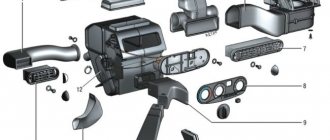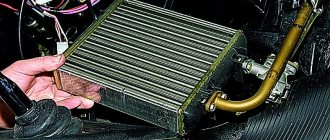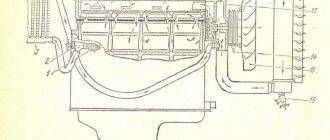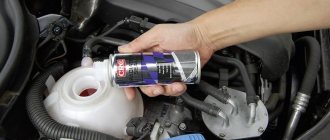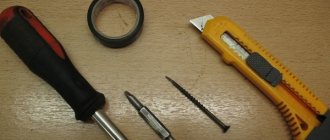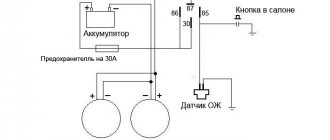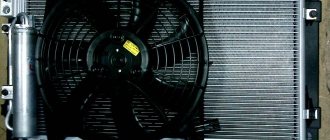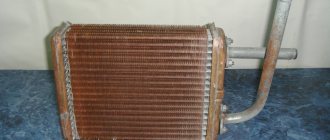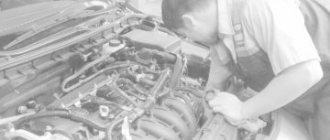Cleaning the car air conditioner, as a rule, is performed when, when it is turned on, an unpleasant odor enters the car interior along with the air flow. This involves cleaning the radiator, evaporator and the air conditioning system itself (air ducts).
Since such a procedure in a car service center is quite expensive (about $70...90), many car enthusiasts are interested in the answer to the question of how to clean the air conditioner in a car with their own hands. And to do this, they use both special chemicals or air conditioning cleaners, and a honey drug - chlorhexidine. Cleaning your car's air conditioner yourself doesn't take much time or effort.
When is cleaning needed?
While the car is moving, the radiator grill takes on all the dust and dirt that comes along the way and clogs the honeycombs. You can find several different radiators in a car: the main one for cooling the engine, for the automatic transmission, and the air conditioner. Sometimes radiators are installed for power steering.
The main radiator is located closer to the engine, so it has less air flow. The remaining heat exchangers only partially reduce their efficiency during operation. And cooling the engine can cause a lot of trouble for the car owner and even lead to a major overhaul of the power unit.
Heat exchangers become clogged both externally and internally. In their cavities, deposits, corrosion and oxidation products of parts made of aluminum alloys accumulate. It is recommended to combine washing of such components with foam and other means with replacing the antifreeze. The timing of this procedure differs for different cars. But, according to the experience of owning a car, after a mileage of 90 thousand km, it is necessary to update the coolant.
Engine efficiency depends on the time of year and ambient temperature. Routine washing and cleaning of the engine radiator is usually carried out in the spring. Before the hot season, it is necessary to remove all foreign particles and dirt from inside the cooling system, since in summer the thermal conditions of the engine are especially important.
Before you start cleaning the radiator, you need to make sure that it is time to do this work. To do this, you need to carry out a simple check that any driver can perform.
Signs of a clogged radiator
If you carefully monitor the operation of the engine and car systems, it is easy to spot signs that it is time to clean the radiator.
- The cooling fan began to operate frequently both at idle and while driving.
- The engine quickly gains temperature, and the antifreeze boils and is thrown out of the expansion tank.
- The upper radiator pipes and hoses are hot, but the lower ones remain cold for a long time.
- The interior heater or air conditioner is not operating efficiently.
- The overheating warning light on the instrument panel lights up.
But the listed signs may indicate other malfunctions:
How to save walls from dirt?
Pay special attention to the wallpaper at the bottom of the air conditioner. This place must be protected from dirty streams and drops.
Mistake #13
It is not enough to simply place a cloth on the floor.
This will not save the wall from dirt. You need to attach something like an apron at the bottom of the block.
They even sell factory packages with everything you need.
More details
In the most economical option, you can attach a covering film with masking tape to the bottom of the block.
Near the floor, gather it into a bun and tape it to the rim of the bucket.
If the air conditioner is too close to the ceiling, then it is advisable to protect it from dirt as well.
How does an engine cooling radiator work and what is it for?
Everyone has seen a radiator in a car. Roughly speaking, this is a lattice metal screen installed in front of the engine. It consists of many tubes (or rather, one very long twisted tube) and thin, foil-like metal plates. Hot coolant flows through the tube, which transfers heat to these plates and also cools due to the air flow blowing onto the radiator. That is, the coolant, circulating through the engine cooling system, takes heat from it, and then enters the radiator, where it releases heat. The radiator has a neck where coolant (antifreeze, antifreeze or water) is poured.
Placement of the condenser on the car and the reasons for its contamination
A condenser is the name of a part of an air conditioner, which among car enthusiasts is called a radiator. In most cases, it is located in the engine compartment of the car, in front of the engine radiator. Technically, this is due to the fact that the best counter-flow of air occurs in this place. In addition, there is also a fan located there, which helps with overheating in the systems.
The refrigerant in a car's air conditioning system is freon. When you turn on the unit, after starting the machine, an electromagnet is triggered, which attracts the compressor pulley to the pressure disk and puts the system into operation. Under the pressure generated by the compressor, freon enters the radiator, where, under the influence of the oncoming air flow and the fan, it cools slightly and turns into liquid.
Then it passes through the receiver to the evaporator, cools the air and is sent back to the compressor. At the same time, moisture settles and accumulates on the evaporator, slowly flowing under the bottom of the car.
During operation, every owner of a car with air conditioning is faced with the fact that an unpleasant odor begins to appear in the cabin.
There are two reasons for this:
- due to the honeycomb becoming clogged with dust, stones and insects, the performance of the air conditioner radiator is reduced, because when it is dirty, it cools the refrigerant coming from the compressor less well;
- Moisture accumulates on the evaporator parts, which, when mixed with dust and dirt, promotes the development of microbes, fungi and mold.
In fact, it’s not just an unpleasant odor. Pathogenic microbes, fungal spores and harmful mold particles begin to enter the cabin, which negatively affects the health of the driver and passengers.
There is only one way out. The air conditioner needs cleaning. The radiator needs to be cleaned. This can be done either in a technical center or with your own hands.
When to wash the radiator
Of course, before you go into the secret places of your car, you need to make sure that there is a need for it. To identify this, you will need a fairly simple diagnosis that you can do yourself. So, first of all, the driver’s attention should be drawn to the frequent activation of the cooling fan when there is no compelling reason for this, such as heat or engine operation under heavy load. This indicates that the cooling of the fluid in the radiator is deteriorating. Perhaps the tubes and antifreeze are clogged or the water is not circulating well.
Also, when the time comes to replace the coolant by draining it from the system, you need to pay attention to foreign particles, cloudiness, and discoloration. If all this occurs, then most likely the radiator is dirty from the inside.
But even if this is not the case, cleaning the engine cooling radiator as a preventative measure will not hurt. By the way, clogged “honeycombs”, that is, the spaces between the plates, as well as deposits on the inner surface are the most common causes of malfunction of the radiator.
Air conditioner disassembly
First of all, pull out the plug from the socket and disconnect the device from the network.
Mistake #2
If your air conditioner worked before, you don’t need to immediately go into its insides.
After unplugging, let it rest for 30 minutes. This time is not included in the total repair duration indicated earlier.
